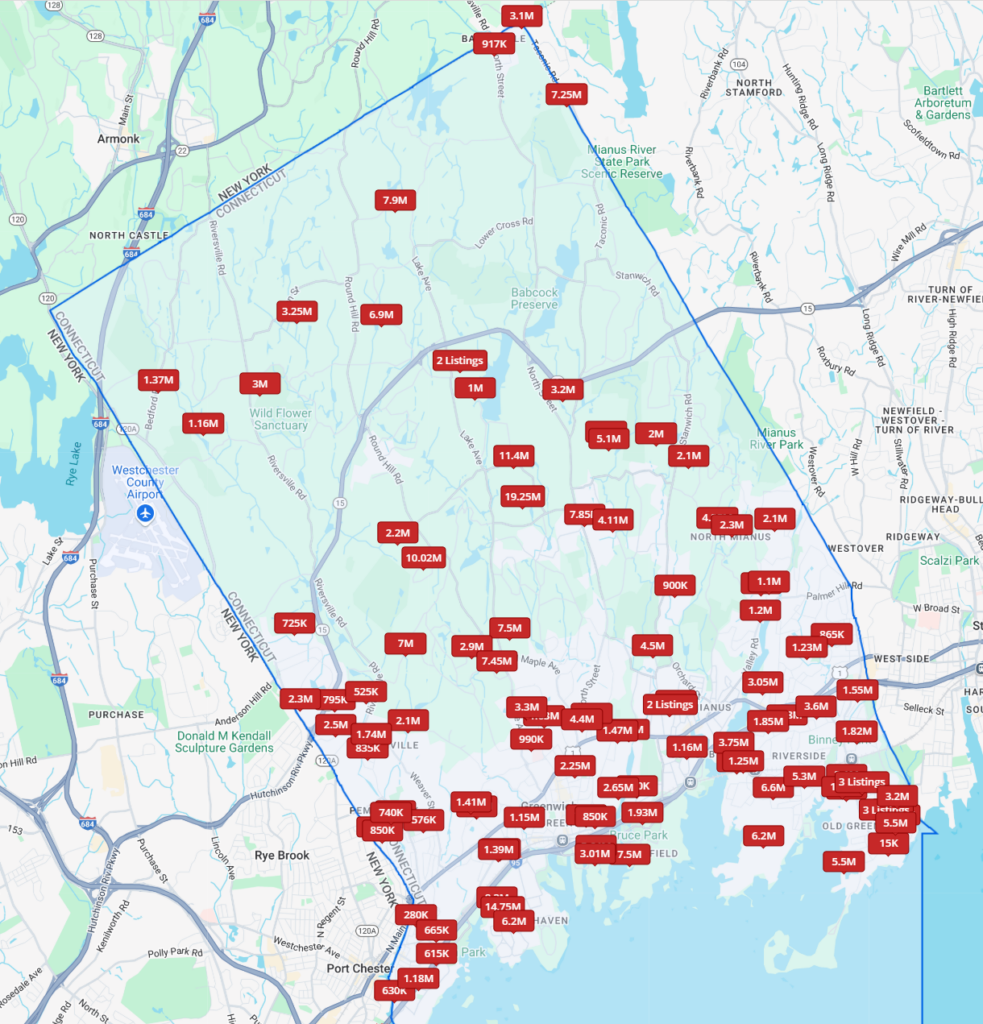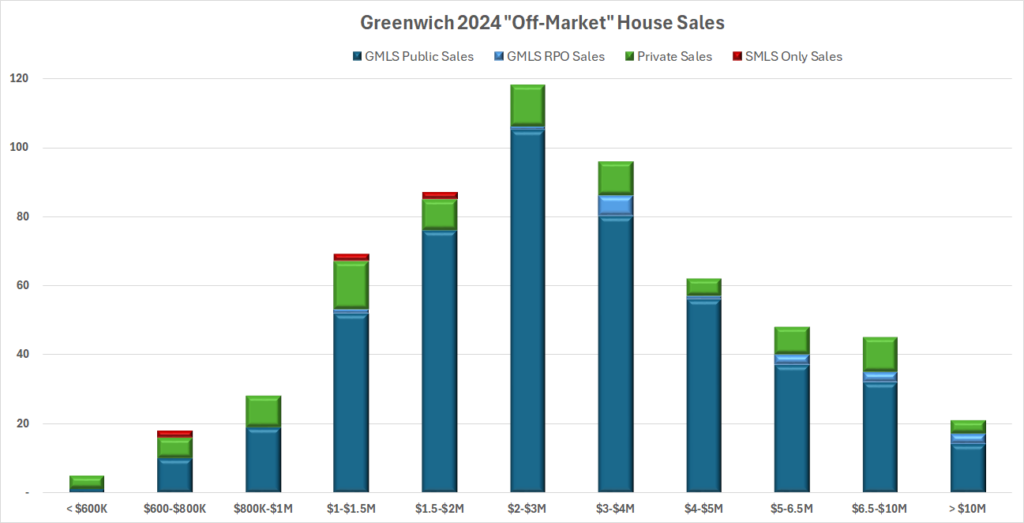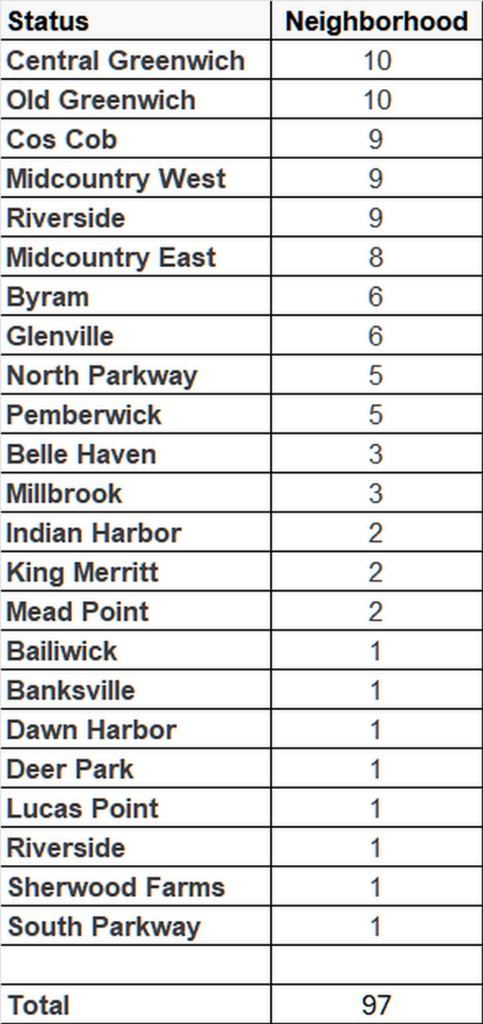In 2024, Greenwich saw 500 single-family home sales that were dissected, examined, analyzed, and scrutinized for what they could reveal about the state of the Greenwich real estate market. However, this analysis mostly missed another 20% of the market that remained hidden unless you knew where to look. These sales are not limited to any one part of town, though they were weighted more towards the affordable end of the market under $1.5 million and the top end of the market over $6.5 million.

The SMLS Sales
A small number of those sales were not that private, because the listing agent only put the listing on the Connecticut-wide Smart MLS not on Greenwich MLS. With the demise of the Darien MLS and the New Canaan MLS at the beginning of this year, the Greenwich MLS is the only remaining town-focused MLS in the State. Six of the 97 “secret” Greenwich sales in 2024 were only listed on the Smart MLS. This usually happens when an agent in Stamford or elsewhere in the state, who doesn’t do much, or often any, business in Greenwich, gets a listing in Greenwich.
Joining the Greenwich MLS is not inexpensive and often too costly for just one house. This is further compounded by the fact that these listings are mostly below our median sales price of $2.86 million. Out of our six total Smart MLS-only listings last year, the highest sale was $1.98 million. Four of the six listings were between $1 and $2 million. These four listings didn’t have much of an impact on the market as we had 129 GMLS-listed sales in that price range.
The other two Smart MLS-only sales were between $600,000 and $800,000, where we only had 10 sales last year on the GMLS. These two sales represented an additional 20% in sales for that price range. In total, the Smart MLS-only sales were only 1.2% of all sales in Greenwich.
Our Private Sales
This is not true of the 91 truly private sales that we had in Greenwich that were never publicly listed. These 91 sales represent an additional 18.2% more sales over the 500 GMLS sales. These sales, however, were not evenly distributed by price. On the GMLS, we had 83 sales under $1.5 million which is 16.6% of our total public Greenwich sales, while our 36 private sales under $1.5 million represent 36.3% of our private sales.
To further complicate things, we had 18 sales that were private but posted to the GMLS for “Reporting Purposes Only”. All but one of these RPO sales are in the upper half of the market. It seems if agents are going to report a private sale, it’s going to be a big one. Counting the SMLS, GMLS-RPO, and true private sales, we had 115 sales that were not listed as active on the GMLS or an additional 19.4% more sales.

In some price categories, the difference without having the private sales is huge. Under $600,000, we had one sale on the GMLS and four private sales. So, using the law of small numbers to make really big percentage differences, we had 400% more private sales than public sales in that price range. Under $1 million, we had 30 public sales and another 19 private sales. The private sales raised the number of sales by 63%. We saw the same thing at the high end. Over $6.5 million, we had 52 public sales and another 14 private sales, which increased our public sales by 26.9%.

Knowing about these private sales is crucial when you are trying to analyze the market in particular price ranges or in particular neighborhoods. Our private sales tend to concentrate in the hottest markets. We’ve seen that the highest percentage of private sales are in our lowest price ranges where we have no or very low months of supply. At the beginning of this year, we had no months of supply all the way up to $1 million, because we had no inventory. So far this year, we have had one listing come under $1 million. It was in Pemberwick and went to contingent contract in seven days, so once again, we have no listings under $1 million.
Listing Does Not Mean It Sells
It’s a frenzied market, and with a couple of phone calls and a few emails, the odds are very good that an agent can get multiple offers on a private sale in our most affordable market. (It’s actually harder than that, but still very doable.) I know what you are going to say, why don’t these sellers list their houses publicly and have a good chance of getting even more money.
Just because it is a super-hot market does not mean that you are guaranteed a sale even under $1 million. Amazingly, seven public listings priced under $1 million expired last year unsold. As mentioned above, we only had 30 GMLS sales under $1 million. These seven unsold listings constituted 23.3% of the GMLS sales in this price range. Of the seven expired houses, the median year built was 1925. By far, however, the biggest reason is that the houses are overpriced for the market.
One way this happens is that the agent or the buyer does a square footage/acreage analysis and doesn’t make the proper adjustments for age, condition, or location. The other way this happens is the seller just thinks their house is worth more, and Zillow, who has never been in the house, says that’s true. Of these 7 expired listings, only 1 listing had a price reduction; the other five kept the price the same. (One house even raised the list price, though some work was done to the house.) In this market, if you don’t have serious offers in the first month, or at the lower end in the first two weeks, it’s very likely overpriced.
The Hot Private Neighborhoods
We also see more private sales in hot neighborhoods. Of our 97 non-GMLS sales, 55 were in five neighborhoods: Central Greenwich, Old Greenwich, Cos Cob, Mid-country, and Riverside. We had 46 public sales in the Old Greenwich school district and an additional 10 private sales in OG for a bump of 21.7% more sales.

Why People Don’t Publicly List?
But still, I hear you say, why didn’t they publicly list the house? Often in a private sale, getting the absolute highest price is not the top priority. If you have an estate situation with heirs scattered all over the country and no one local, clearing out the house and fixing it up is too much work for people with busy lives who aren’t in the area. Also, many people don’t have the money, nor the physical ability to fix up the house.
I have a minor specialty in listing houses owned by elderly widows. Often, they have a physical impairment that makes getting around difficult. The idea of packing boxes and sorting through decades of memories and accumulated stuff is just too much work and too much stress and they don’t have the money.
Many of the local brokers have finance programs, such as Compass Concierge, to help fix up houses, but that means strangers are going to be in their house. That last issue is a bigger issue than you might think, as many of our senior owners are embarrassed by the state of their houses. Putting pictures of the house all over the Internet and hosting public open houses is not something they are willing to do.
At the high end, homeowners can be just as resistant to publicly listing their house. Once again, they often don’t want photos of their house being made public for everyone to see. For some homeowners, photo-shopping the valuable artwork out is sufficient, but they still want as few qualified buyers in to see the house as possible, while still getting a good price for the house.
Dealing With New Rules
Due to the tight market, we as realtors are seeing a lot more regulations about how and when we list houses. The National Association of Realtors has promulgated the Clear Cooperation Policy. They require that all houses be publicly listed within 24 hours of getting a listing unless the owner agrees to keep it private for a period of time. In Greenwich, you have to keep the listing private for four months before you can publicly list. If you do list it before that time, the listing fee goes from $70 to $1,000.
Since the listings are private, you can’t send out bulk emails to your fellow agents, no mentions or allusions to a private listing on social media are allowed. You can’t advertise the listing, nor can you have a public open house. All of these rules have been created to make sure that a private listing is truly private, known only to a few. Their purpose is to make as many listings fully public as quickly as possible.
Unfortunately, these very strict rules don’t work for many homeowners, and many buyers don’t hear about listings that they would be interested in. Personally, I would love to have a semi-public listing and leave it up to the broker and the homeowner to decide how a listing should be marketed. One thing that GMLS members are allowed to do is to make a listing “public” but limit it only to GMLS members by turning off the IDX feed. Public listing info is sent out in this Internet Data eXchange the format to all the public websites, whether Zillow, the New York Times, or a local Greenwich broker, get.
By turning off the IDX feed, the only place the information is available is on the Greenwich MLS to MLS members. Even if we do this, we are still required to post at least six images, and if they are virtually staged, you have to label that photo and also post a picture showing the room “as is.” It would be nice to let the homeowner decide what pictures they want up. If they are virtually staged, they should say that, but why not give the homeowner the choice of not posting, say, the master bedroom photo “as is” but only post a virtually staged photo too.
Given that our inventory continues to be at all-time record lows, with only 87 houses listed, I’d love to see more efforts to make more private listings semi-public listings with the seller deciding how they want to list the house.
The Spring Market?
Stay tuned and hope for more listings in the spring market. As yet, we have seen no signs of it. We had 30 sales in January 2025, when our ten-year average is 40 sales. This week, we have had nine sales and 11 new listings for a net gain of two, as set out in Tim Agro’s adjacent weekly Greenwich Sentinel report. Anything to get more listings would help everybody, even sellers, as they would have a place to move to.







